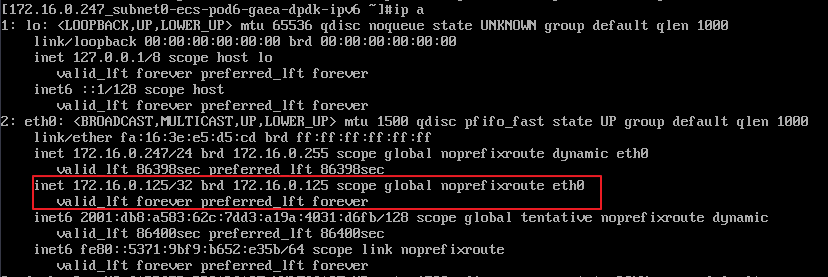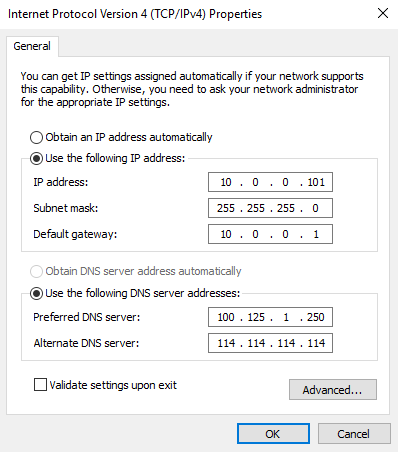Binding a Virtual IP Address to an Instance or EIP
Scenarios
You can bind a virtual IP address to an instance or EIP.
- Bind a virtual IP address to an instance. You can:
- Bind one or more virtual IP addresses to an instance.
- Bind a virtual IP address to multiple instances.
- Bind a virtual IP address to an EIP to enable public network communication.
Constraints
It is recommended that a maximum of eight virtual IP addresses be bound to an ECS. If an ECS has multiple virtual IP addresses, each virtual IP address is used by a specific service. If there are too many services, the ECS may become overloaded and compromise user experience.
Binding a Virtual IP Address to an EIP or ECS on the Console
- Log in to the management console.
- Click
 in the upper left corner and choose Network > Virtual Private Cloud.
in the upper left corner and choose Network > Virtual Private Cloud.The Virtual Private Cloud page is displayed.
- In the navigation pane on the left, choose Virtual Private Cloud > Subnets.
The Subnets page is displayed.
- In the subnet list, locate the target subnet and click its name.
The subnet details page is displayed.
- On the IP Addresses tab, bind an EIP to the virtual IP address:
- Locate the row that contains the virtual IP address and click Bind to EIP in the Operation column.
The Bind to EIP dialog box is displayed.
- Select an EIP and click OK.
In the virtual IP address list, you can view the bound EIP.
- Locate the row that contains the virtual IP address and click Bind to EIP in the Operation column.
- On the IP Addresses tab, bind an instance to the virtual IP address:
- Locate the row that contains the virtual IP address and click Bind to Server in the Operation column.
The Bind to Server dialog box is displayed.
- Select an instance and click OK.
In the virtual IP address list, you can view the bound instance.
Notice- After you bind one or more virtual IP addresses to an ECS, you need to manually configure the virtual IP addresses on the ECS. For details, see Configuring a Virtual IP Address for an ECS.
- Locate the row that contains the virtual IP address and click Bind to Server in the Operation column.
Configuring a Virtual IP Address for an ECS
After you bind one or more virtual IP addresses to an ECS on the console, you must log in to the ECS to manually configure these virtual IP address.
The following OSs are used as examples here. For other OSs, see the help documents on their official websites. The configurations for ECSs will not be lost after restart.
- Linux: CentOS 7.2 64bit and Ubuntu 22.04 server 64bit
- Windows: Windows Server
Linux (CentOS)
The following uses CentOS 7.2 64bit as an example.
- Obtain the network interface that the virtual IP address is to be bound and the connection of the network interface:
nmcli connection
Information similar to the following is displayed:

The command output in this example is described as follows:
- eth0 in the DEVICE column indicates the network interface that the virtual IP address is to be bound.
- Wired connection 1 in the NAME column indicates the connection of the network interface.
- Add the virtual IP address for the connection:
nmcli connection modify "<connection-name-of-the-network-interface>" +ipv4.addresses <virtual-IP-address>
Configure the parameters as follows:
- connection-name-of-the-network-interface: The connection name of the network interface obtained in 1. In this example, the connection name is Wired connection 1.
- virtual-IP-address: Enter the virtual IP address to be added. If you add multiple virtual IP addresses at a time, separate every two with a comma (,).
Example commands:
- Adding a single virtual IP address: nmcli connection modify "Wired connection 1" +ipv4.addresses 172.16.0.125
- Adding multiple virtual IP addresses: nmcli connection modify "Wired connection 1" +ipv4.addresses 172.16.0.125,172.16.0.126
- Make the configuration in 2 take effect:
nmcli connection up "<connection-name-of-the-network-interface>"
In this example, run the following command:
nmcli connection up "Wired connection 1"
Information similar to the following is displayed:

- Check whether the virtual IP address has been bound:
ip a
Information similar to the following is displayed. In the command output, the virtual IP address 172.16.0.125, is bound to network interface eth0.
 Note
NoteTo delete an added virtual IP address, perform the following steps:
- Delete the virtual IP address from the connection of the network interface:
nmcli connection modify "<connection-name-of-the-network-interface>" -ipv4.addresses <virtual-IP-address>
To delete multiple virtual IP addresses at a time, separate every two with a comma (,). Example commands are as follows:
- Deleting a single virtual IP address: nmcli connection modify "Wired connection 1" -ipv4.addresses 172.16.0.125
- Deleting multiple virtual IP addresses: nmcli connection modify "Wired connection 1" -ipv4.addresses 172.16.0.125,172.16.0.126
- Make the deletion take effect by referring to 3.
- Delete the virtual IP address from the connection of the network interface:
Linux (Ubuntu)
The following uses Ubuntu 22.04 server 64bit as an example. If the ECS runs Ubuntu 22 or Ubuntu 20, perform the following operations:
- Obtain the network interface that the virtual IP address is to be bound:
ifconfig
Information similar to the following is displayed. In this example, the network interface bound to the virtual IP address is eth0.
root@ecs-X-ubantu:~# ifconfigeth0: flags=4163<UP,BROADCAST,RUNNING,MULTICAST> mtu 1500inet 172.16.0.210 netmask 255.255.255.0 broadcast 172.16.0.255inet6 fe80::f816:3eff:fe01:f1c3 prefixlen 64 scopeid 0x20<link>ether fa:16:3e:01:f1:c3 txqueuelen 1000 (Ethernet)RX packets 43915 bytes 63606486 (63.6 MB)RX errors 0 dropped 0 overruns 0 frame 0TX packets 3364 bytes 455617 (455.6 KB)TX errors 0 dropped 0 overruns 0 carrier 0 collisions 0... - Switch to the /etc/netplan directory:
cd /etc/netplan
- Add a virtual IP address to the network interface.
- Open the configuration file 01-netcfg.yaml:
vim 01-netcfg.yaml
- Press i to enter the editing mode.
- In the network interface configuration area, add a virtual IP address.
In this example, add a virtual IP address for eth0:
addresses:
- 172.16.0.26/32
The file content is as follows:
network:version: 2renderer: NetworkManagerethernets:eth0:dhcp4: trueaddresses:- 172.16.0.26/32eth1:dhcp4: trueeth2:dhcp4: trueeth3:dhcp4: trueeth4:dhcp4: true - Press Esc, enter :wq!, save the configuration, and exit.
- Open the configuration file 01-netcfg.yaml:
- Make the configuration in 3 take effect:
netplan apply
- Check whether the virtual IP address has been bound:
ip a
Information similar to the following is displayed. In the command output, virtual IP address 172.16.0.26 is bound to network interface eth0.
root@ecs-X-ubantu:/etc/netplan# ip a...2: eth0: <BROADCAST,MULTICAST,UP,LOWER_UP> mtu 1500 qdisc fq_codel state UP group default qlen 1000link/ether fa:16:3e:01:f1:c3 brd ff:ff:ff:ff:ff:ffaltname enp0s3altname ens3inet 172.16.0.26/32 scope global noprefixroute eth0valid_lft forever preferred_lft foreverinet 172.16.0.210/24 brd 172.16.0.255 scope global dynamic noprefixroute eth0valid_lft 107999971sec preferred_lft 107999971secinet6 fe80::f816:3eff:fe01:f1c3/64 scope linkvalid_lft forever preferred_lft forever
Windows: Windows Server
The following operations use Windows Server as an example.
- In Control Panel, click Network and Sharing Center, and click the corresponding local connection.
- On the displayed page, click Properties.
- On the Network tab page, select Internet Protocol Version 4 (TCP/IPv4).
- Click Properties.
- Select Use the following IP address and set IP address to the private IP address of the ECS, for example, 10.0.0.101.
Figure 1 Configuring private IP address

- Click Advanced.
- On the IP Settings tab, click Add in the IP addresses area.
Add the virtual IP address, for example, 10.0.0.154.
Figure 2 Configuring virtual IP address

- Click OK.
- In the Start menu, open the Windows command line window and run the following command to check whether the virtual IP address has been configured:
ipconfig /all
In the command output, IPv4 Address is the virtual IP address 10.0.0.154, indicating that the virtual IP address of the ECS's network interface has been correctly configured.
- Scenarios
- Constraints
- Binding a Virtual IP Address to an EIP or ECS on the Console
- Configuring a Virtual IP Address for an ECS
- Linux (CentOS)
- Linux (Ubuntu)
- Windows: Windows Server